Related Research Articles

The United States Asiatic Fleet was a fleet of the United States Navy during much of the first half of the 20th century. Before World War II, the fleet patrolled the Philippine Islands. Much of the fleet was destroyed by the Japanese by February 1942, after which it was dissolved, and the remnants incorporated into the naval component of the South West Pacific Area command, which eventually became the Seventh Fleet.

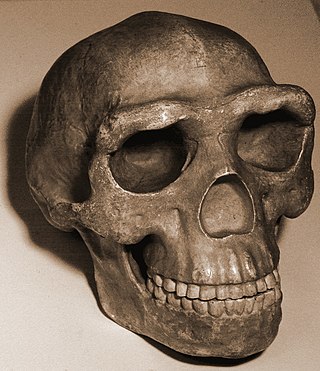
Peking Man is a subspecies of H. erectus which inhabited the Zhoukoudian cave site in modern northern China during the Chibanian. The first fossil, a tooth, was discovered in 1921, and the Zhoukoudian Cave has since then become the most productive H. erectus site in the world. Peking Man was instrumental in the foundation of Chinese anthropology, and fostered an important dialogue between Western and Eastern science for decades to come. The fossils became the centre of anthropological discussion, and were classified as a direct human ancestor, propping up the Out of Asia hypothesis that humans evolved in Asia. Peking Man also played a vital role in the restructuring of the Chinese identity following the Chinese Communist Revolution, and was intensively communicated to working class and peasant communities to introduce them to Marxism and science. Early models of Peking Man society strongly leaned towards communist or nationalist ideals, leading to discussions on primitive communism and polygenism. This produced a strong schism between Western and Eastern interpretations, especially as the West adopted the Out of Africa hypothesis by late 1967, and Peking Man's role in human evolution diminished as merely an offshoot of the human line. Though Out of Africa is now the consensus, Peking Man interbreeding with human ancestors is frequently discussed especially in Chinese circles.
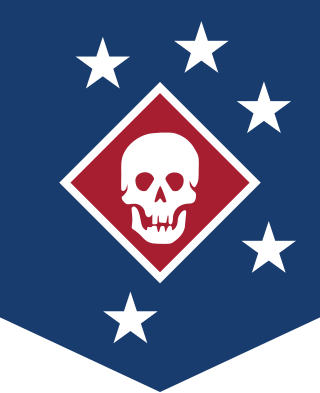
The Marine Raiders were special operations forces originally established by the United States Marine Corps during World War II to conduct amphibious light infantry warfare. "Edson's" Raiders of 1st Marine Raider Battalion and "Carlson's" Raiders of 2nd Marine Raider Battalion are said to have been the first United States special operations forces to form and see combat during World War II.
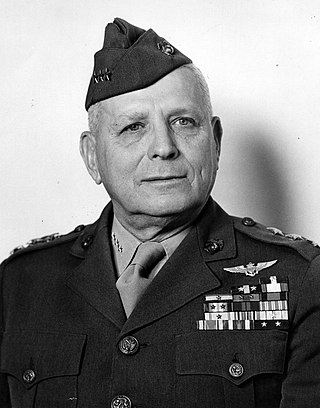
General Roy Stanley Geiger was a United States Marine Corps four-star general who served in World War I and World War II. In World War II, he became the first Marine Corps general to lead a field army.

The 1st Marine Division is a Marine division of the United States Marine Corps headquartered at Marine Corps Base Camp Pendleton, California. It is the ground combat element of the I Marine Expeditionary Force.

The 4th Marine Regiment is an infantry regiment of the United States Marine Corps. Based at Camp Schwab in Okinawa, Japan, it is part of the 3rd Marine Division of the III Marine Expeditionary Force.
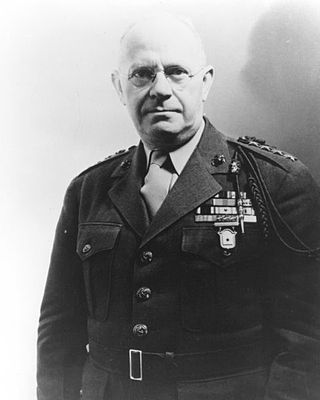
General Thomas Holcomb was a United States Marine Corps officer who served as the seventeenth Commandant of the Marine Corps from 1936 to 1943. He was the first Marine to achieve the rank of general, and was a strong supporter of racial segregation in the Marine Corps. After retiring from the Marine Corps, Holcomb served as the U.S. Envoy Extraordinary and Minister Plenipotentiary to South Africa from 1944 to 1948. One of his ancestors was Joshua Barney, a naval hero of the War of 1812.
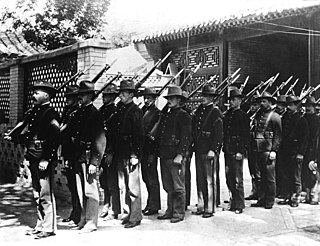
The term China Marines, originally referred to the United States Marines of the 4th Marine Regiment, who were stationed in Shanghai, China from 1927 to 1941 to protect American citizens and their property in the Shanghai International Settlement, during the Chinese Revolution and the Second Sino-Japanese War. Those Marines stationed at the embassy in Beijing and the consulate in Tianjin referred to themselves as North China Marines.

The history of the United States Marine Corps (USMC) begins with the founding of the Continental Marines on 10 November 1775 to conduct ship-to-ship fighting, provide shipboard security and discipline enforcement, and assist in landing forces. Its mission evolved with changing military doctrine and foreign policy of the United States. Owing to the availability of Marine forces at sea, the United States Marine Corps has served in nearly every conflict in United States history. It attained prominence when its theories and practice of amphibious warfare proved prescient, and ultimately formed a cornerstone of U.S. strategy in the Pacific Theater of World War II. By the early 20th century, the Marine Corps would become one of the dominant theorists and practitioners of amphibious warfare. Its ability to rapidly respond on short notice to expeditionary crises has made and continues to make it an important tool for U.S. foreign policy.


Marine Defense Battalions were United States Marine Corps battalions charged with coastal and air defense of advanced naval bases during World War II. They maintained large anti-ship guns, anti-aircraft guns, searchlights, and small arms to repel landing forces.
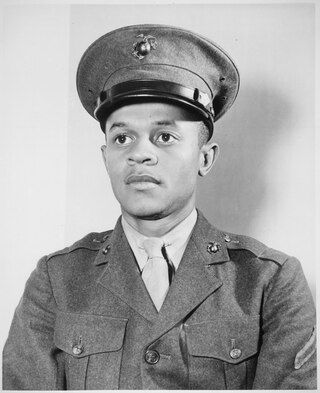
The United States Marine Corps (USMC) is a desegregated force, made up of troops of all races working and fighting alongside each other. In 1776 and 1777, a dozen African American Marines served in the American Revolutionary War, but from 1798 to 1942, the USMC followed a racially discriminatory policy of denying African Americans the opportunity to serve as Marines. For more than 140 years, the Marines recruited primarily European Americans and Hispanic and Latino Americans, along with a few Asian Americans.
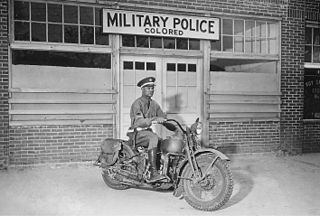
A series of policies were formerly issued by the U.S. military which entailed the separation of white and non-white American soldiers, prohibitions on the recruitment of people of color and restrictions of ethnic minorities to supporting roles. Since the American Revolutionary War, each branch of the United States Armed Forces implemented differing policies surrounding racial segregation. Racial discrimination in the U.S. military was officially opposed by Harry S. Truman's Executive Order 9981 in 1948. The goal was equality of treatment and opportunity. Jon Taylor says, "The wording of the Executive Order was vague because it neither mentioned segregation or integration." Racial segregation was ended in the mid-1950s.

Operation Beleaguer was the codename for the United States Marine Corps’ occupation of northeastern China’s Hebei and Shandong provinces from 1945 until 1949. The Marines were tasked with overseeing the repatriation of more than 600,000 Japanese and Koreans that remained in China at the end of World War II. During the four-year occupation, American forces engaged in several skirmishes with the People's Liberation Army while successfully evacuating thousands of foreign nationals. The United States Government attempted to mediate a peace treaty between the opposing Nationalist and Communist factions but was unsuccessful. The Marines departed Northern China in June 1949 a few months before the communists won victory in the Chinese Civil War and took control of mainland China.

Clayton Barney Vogel was a United States Marine Corps officer with the rank of major general who served in a variety of capacities from 1902 until 1946. He is best known for his support of the Navajo code talker program.
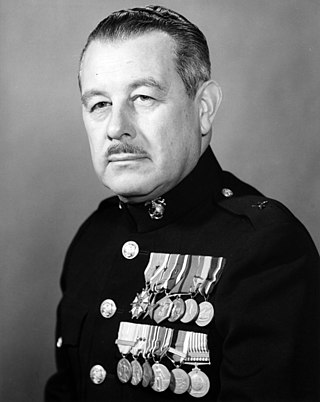
Bankson Taylor Holcomb Jr. was a decorated officer of the United States Marine Corps with the rank of brigadier general. He is most noted for his service as cryptanalyst and Linguist for Admirals Halsey and Spruance during the Pacific War or as Intelligence Officer of the 1st Marine Division during the Korean War. He was also a cousin of Commandant of the Marine Corps General Thomas Holcomb.

The History of ground based air defense in the United States Marine Corps dates back to the early 1930s with the establishment of the Advanced Base Force. World War II would be the high-water mark for air defense units when 20+ defense/anti-aircraft battalions were formed with many seeing significant action throughout the Pacific Theater. Following the war, the Marine Corps divested itself of most of its air defense capability at a time when the service was facing deep personnel cuts and fighting for its institutional survival. Beginning in the early 1950s the Marine Corps aligned itself with the Navy and their development of surface-to-air missiles (SAMs). The Marine Corps retained both flak weapons and SAMs throughout the 1950s until the fielding of the MIM-23 Hawk Missile System in 1960. The HAWK Missile was employed by Light Antiaircraft Missile (LAAM) battalions and remained a mainstay of Marine Corps ground based air defense for the next four decades.

The 51st Defense Battalion was an antiaircraft and coastal defense unit in the United States Marine Corps that served during World War II. The battalion was originally formed in August 1942 and was the first African American unit in the Marine Corps. Its original mission was to provide air and coastal defense for advanced naval bases. During the war the battalion served in the Ellice and Marshall Islands, in the Pacific Theater. The 51st returned to Marine Corps Base Camp Lejeune, North Carolina after the war and was decommissioned on January 31, 1946. To date, no other Marine Corps battalion has carried the lineage and honors of the 51st Defense Battalion.
References
- 1 2 Tyson, Carolyn A. (1965). "A Chronology of the United States Marine Corps 1935-1946". II. History And Museums Division Headquarters, U.S. Marine Corps. Retrieved 28 March 2012.
{{cite journal}}: Cite journal requires|journal=(help) - ↑ Amy Bucci (22 March 2012). "Are the Lost Peking Man Fossils Buried Under a Parking Lot in China?". National Geographic Society. Archived from the original on March 22, 2012. Retrieved 28 March 2012.